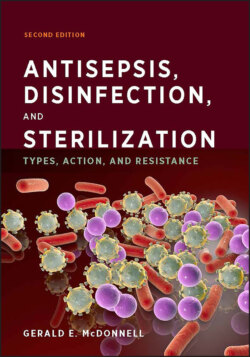Читать книгу Antisepsis, Disinfection, and Sterilization - Gerald E. McDonnell - Страница 26
1.3.6 Prions
ОглавлениеPrions are unique infectious agents that are composed exclusively of protein and do not appear to have an associated nucleic acid. The protein in question is a normal cellular protein (cellular prion protein [PrPc]) that is expressed in many body tissues and in all vertebrates, including humans and animals. The proteins are produced in cells as long chains of amino acids (known as the primary structure), which then fold to make structural and functional (e.g., enzyme) forms (e.g., secondary and tertiary structures). The exact function of the PrP protein is unknown, but it is known to be a eukaryotic cell membrane-associated glycoprotein. Like other cellular proteins, PrP is manufactured by the cell and can be subsequently broken down by normal cellular processes (Fig. 1.13).
However, PrP appears to be able to change its conformational secondary structure into insoluble, “infectious” forms (PrPSc). The conformational change to PrPSc renders the protein highly resistant to normal cellular degradative processes, leading to accumulation and cell damage or death, with particular consequences to neural tissues. More specifically, an insoluble portion of the protein (PrP27-30, a 27- to 30-kDa protein) accumulates to form amyloid deposits in the brain. Therefore, the protein primary structure does not change, but the protein secondary structure is radically altered to give an overall greater proportion of β-sheets over α-helices in the folded protein structure (Fig. 1.14). What triggers this reaction is currently unknown; PrPSc itself has been shown to be involved in the transition, but it may also require other, yet unidentified factors.
FIGURE 1.13 Theory of prions as infectious proteins. PrPc is the normal form of the protein, and PrPSc the abnormal form.
Prions are the causative agents in a group of diseases known as transmissible spongiform encephalopathies. Animal (scrapie in sheep and bovine spongiform encephalopathy in cattle) and human (classical Creutzfeldt-Jakob disease [CJD] and variant CJD) diseases have been shown to be infectious prion diseases. Some forms have also been found to be inherited, e.g., familial CJD is responsible for ~10% of CJD cases and Gerstmann-Sträussler-Scheinker syndrome, due to modifications in the PrP-encoding gene. Human diseases are considered very rare; for example, CJD is the most common human transmissible spongiform encephalopathy, with an approximate rate of 1 to 1.5 cases per 1,000,000 population. Animal diseases are considered more widespread; for example, scrapie is estimated to affect 4 to 8% of sheep. Prions have been shown to be transferred in contaminated tissues (including infected foods, neural tissues, and blood) and on the surfaces of contaminated instruments (surgical devices). Zoonotic transmission to humans has been reported, with bovine spongiform encephalopathy now widely accepted as the source of variant CJD in humans. Finally, some researchers have speculated that other diseases that are associated with the deposition of protein (for example, the neurodegenerative diseases Parkinson’s and Alzheimer’s diseases) could also be linked to infectious agents; these reports, however, remain to be substantiated.
FIGURE 1.14 Representation of the proposed structural changes in PrP.
